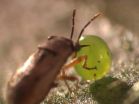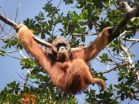(Press-News.org) Tampa, FL (Oct. 16, 2012) -- A landmark paper identifying genetic signatures that predict which patients will respond to a life-saving drug for treating congestive heart failure has been published by a research team co-led by Stephen B. Liggett, MD, of the University of South Florida.
The study, drawing upon a randomized placebo-controlled trial for the beta blocker bucindolol, apprears this month in the online international journal PLoS ONE. In addition to Dr. Liggett, whose laboratory discovered and characterized the two genetic variations, Christopher O'Connor, MD, of Duke University Medical Center, and Michael Bristow, MD, PhD, of ARCA biopharma and the University of Colorado Anschutz Medical Campus, were leading members of the research team.
The analysis led to a "genetic scorecard" for patients with congestive heart failure, a serious condition in which the heart can't pump enough blood to meet the body's needs, said Dr. Liggett, the study's co-principal investigator and the new vice dean for research and vice dean for personalized medicine and genomics at the USF Morsani College of Medicine.
"We have been studying the molecular basis of heart failure in the laboratory with a goal of finding genetic variations in a patient's DNA that alter how drugs work," Dr. Liggett said. "We took this knowledge from the lab to patients and found that we can indeed, using a two-gene test, identify individuals with heart failure who will not respond to bucindolol and those who have an especially favorable treatment response. We also identified those who will have an intermediate level of response."
The research has implications for clinical practice, because the genetic test could theoretically be used to target the beta blocker to patients the drug is likely to help. Equally important, its use could be avoided in patients with no likelihood of benefit, who could then be spared potential drug side effects. Prospective studies are needed to confirm that bucindolol would be a better treatment than other classes of beta blockers for a subset of patients with health failure.
Dr. Liggett collaborated with medical centers across the United States, including the NASDAq-listed biotech company ARCA biopharma, which he co-founded in Denver, CO. This genetic sub-study involved 1,040 patients who participated in the Beta-Blocker Evaluation of Survival Trial (BEST). The researchers analyzed mortality, hospital admissions for heart failure exacerbations and other clinical outcome indicators of drug performance.
"The results showed that the choice of the best drug for a given patient, made the first time without a trial-and-error period, can be accomplished using this two-gene test," Dr. Liggett said.
The genetic test discovered by the Liggett team requires less than 1/100th of a teaspoon of blood drawn from a patient, from which DNA is isolated. DNA is highly stable when frozen, so a single blood draw will suffice for many decades, Dr. Liggett said. And since a patient's DNA does not change over their lifetime, as new discoveries are made and other tests need to be run, it would not be necessary to give another blood sample, he added.
This is part of the strategy for the USF Center for Personalized Medicine and Genomics. The discovery of genetic variations in diseases can be targeted to predict three new types of information: who will get a disease, how the disease will progress, and the best drug to use for treatment.
"In the not too distant future, such tests will become routine, and patient outcomes, and the efficiency and cost of medical care will be impacted in positive ways. We also will move toward an era where we embrace the fact that one drug does not fit all," Dr. Liggett said. "If we can identify by straightforward tests which drug is best for which patient, drugs that work with certain smaller populations can be brought to the market, filling a somewhat empty pipeline of new drugs."
This approach is applicable to most diseases, Dr. Liggett said, but the USF Center has initially concentrated on heart disease, because it is a leading cause of deaths, hospitalizations and lost productivity in the Tampa Bay region and Florida. Dr. Liggett is a recent recruit to the USF Health Morsani College of Medicine, coming from the University of Maryland School of Medicine. His work at USF has been supported by several National Institutes of Health grants and $2 million in funding from Hillsborough County.
Heart failure is characterized by an inability of the heart muscle to pump blood, resulting in dysfunction of multiple organs caused by poor blood and oxygen flow throughout the body. An estimated 6 million Americans are living with heart failure, and more than half a million new cases are diagnosed each year. About 50 percent of patients diagnosed with heart failure die within five years. The economic burden of heart failure in the United States is estimated at $40 billion a year.
INFORMATION:
Article citation:
Christopher M. O'Connor, Mona Fiuzat, Peter E. Carson, Inder S. Anand, Jonathan F. Plehn, Stephen S. Gottlieb, Marc A. Silver, JoAnn Lindenfeld, Alan B. Miller, Michel White, Ryan Walsh, Penny Nelson, Allen Medway, Gordon Davis, Alastair D. Robertson, J. David Port, James Carr, Guinevere A. Murphy, Laura C. Lazzeroni, William T. Abraham, Stephen B. Liggett and Michael Bristow, "Combinatorial Pharmacogenetic Interactions of Bucindolol and β1, α2C Adrenergic Receptor Polymorphisms," PLoS ONE 7(10): e44324. http://dx.plos.org/10.1371/journal.pone.0044324
-USF Health-
USF Health's mission is to envision and implement the future of health. It is the partnership of the USF Health Morsani College of Medicine, the College of Nursing, the College of Public Health, the College of Pharmacy, the School of Biomedical Sciences and the School of Physical Therapy and Rehabilitation Sciences; and the USF Physician's Group. The University of South Florida is a global research university ranked 50th in the nation by the National Science Foundation for both federal and total research expenditures among all U.S. universities.
2-gene test predicts which patients with heart failure respond best to beta-blocker drug
Personalized medicine research at the University of South Florida strikes early for heart genes
2012-10-16
ELSE PRESS RELEASES FROM THIS DATE:
Green leaf volatiles increase plant fitness via biocontrol
2012-10-16
This press release is available in German.
To solve the acute, global problem of securing food resources for a continuously growing population, we must work constantly to increase the sustainability and effectiveness of modern agricultural techniques. These efforts depend on new insights from plant ecology, particularly from work on native plants that grow in the primordial agricultural niche. Based on field studies on wild tobacco plants in the Great Basin Desert, Utah, USA, researchers of the Max Planck Institute for Chemical Ecology in Jena, Germany, demonstrated that ...
An extremely brief reversal of the geomagnetic field, climate variability and a super volcano
2012-10-16
An extremely brief reversal of the geomagnetic field, climate variability and a super volcano
41,000 years ago, a complete and rapid reversal of the geomagnetic field occured. Magnetic studies of the GFZ German Research Centre for Geosciences on sediment cores from the Black Sea show that during this period, during the last ice age, a compass at the Black Sea would have pointed to the south instead of north. Moreover, data obtained by the research team formed around GFZ researchers Dr. Norbert Nowaczyk and Prof. Helge Arz, together with additional data from other studies ...
Link between creativity and mental illness confirmed
2012-10-16
People in creative professions are treated more often for mental illness than the general population, there being a particularly salient connection between writing and schizophrenia. This according to researchers at Karolinska Institutet in Sweden, whose large-scale registry study is the most comprehensive ever in its field.
Last year, the team showed that artists and scientists were more common amongst families where bipolar disorder and schizophrenia is present, compared to the population at large. They subsequently expanded their study to many more psychiatric diagnoses ...
Non-coding antisense RNA can be used to stimulate protein production
2012-10-16
While studying Parkinson's disease, an international research group made a discovery which can improve industrial protein synthesis for therapeutic use. They managed to understand a novel function of non-protein coding RNA: the protein synthesis activity of coding genes can be enhanced by the activity of the non-coding one called "antisense."
To synthesize proteins, the DNA needs RNA molecules serving as short "transcriptions" of the genetic information. The set of all these RNA molecules is called "transcriptome." In the human transcriptome, along with around 25 thousand ...
Genetic protection against arsenic
2012-10-16
Evolution has not only controlled human development over millions of years, it also has an impact on modern man. This is one of the conclusions of a study of Argentinian villagers in the Andes, where the water contains high levels of arsenic. A gene variant that produces efficient and less toxic metabolism of arsenic in the body was much more common among the villagers than among other indigenous groups in South or Central America. The study was a collaborative effort by Karin Broberg from Lund University and Carina Schlebusch and Mattias Jakobsson from Uppsala University ...
Dark matter filament studied in 3-D for the first time
2012-10-16
Astronomers using the NASA/ESA Hubble Space Telescope have studied a giant filament of dark matter in 3D for the first time. Extending 60 million light-years from one of the most massive galaxy clusters known, the filament is part of the cosmic web that constitutes the large-scale structure of the Universe, and is a leftover of the very first moments after the Big Bang. If the high mass measured for the filament is representative of the rest of the Universe, then these structures may contain more than half of all the mass in the Universe.
The theory of the Big Bang predicts ...
The sound in Saturn's rings: RUB-Physicists explain nonlinear dust acoustic waves in dusty plasmas
2012-10-16
Dusty plasmas can be found in many places both in space and in the laboratory. Due to their special properties, dust acoustic waves can propagate inside these plasmas like sound waves in air, and can be studied with the naked eye or with standard video cameras. The RUB physicists Prof. Dr. Dr. h.c. Padma Kant Shukla and Dr. Bengt Eliasson from the Faculty of Physics and Astronomy have published a model with which they describe how large amplitude dust acoustic waves in dusty plasmas behave. The researchers report their new findings in the journal Physical Review E.
Different ...
Novel discovery links anti-cancer drugs to muscle repair
2012-10-16
OTTAWA, October 16, 2012 – Few drugs are available to treat muscle injury, muscle wasting and genetic disorders causing muscle degeneration, such as Duchenne muscular dystrophy. A compelling discovery that may change this was made recently by a research group led by Dr. Robert Korneluk, distinguished professor at University of Ottawa's Faculty of Medicine and founder of the CHEO Research Institute's Apoptosis Research Centre, was reported today in Science Signaling.
"We know of five pharmaceutical companies pursuing phase one clinical trials with specific drugs to treat ...
Pollenizer research should help seedless watermelon farmers
2012-10-16
Research from North Carolina State University on flower production and disease resistance in watermelon varieties should help bolster seedless watermelon harvests for farmers.
Seedless watermelons are more popular than seeded watermelons, making them a more profitable crop for farmers. But the flowers of seedless watermelon plants must be fertilized with pollen from the male flowers of seeded watermelon plants, because seedless plants do not produce genetically viable pollen.
This is a problem, because seeded watermelon plants take up space, nutrients and water that ...
A change of strategy is needed to save the Sumatran orangutans
2012-10-16
This press release is available in German.
Orangutans are the only large apes in Asia and mainly live in trees. Today, the population only includes two species: While the Borneo orangutan populates large sections of the Southeast Asian island of Borneo, nowadays the Sumatran orangutan is only found at the northern tip of the island of Sumatra. With a current population of only around 6,600 Sumatra orangutans, a figure which is dropping rapidly and constantly, this species is on the Red List of Threatened Species.
When large areas of rainforest were cleared in Sumatra ...
LAST 30 PRESS RELEASES:
New deep-learning tool can tell if your salmon is wild or farmed
If you're over 60 and playing with sex toys, you're not alone
Fame itself may be critical factor in shortening singers’ lives
Daily coffee drinking may slow biological ageing of people with major mental illness
New highly efficient material turns motion into power – without toxic lead
The DEVILS in the details: New research reveals how the cosmic landscape impacts the galaxy lifecycle
After nearly 100 years, scientists may have detected dark matter
Gender imbalance hinders equitable environmental governance, say UN scientists
Six University of Tennessee faculty among world’s most highly cited researchers
A type of immune cell could hold a key to preventing scar tissue buildup in wounds
Mountains as water towers: New research highlights warming differences between high and low elevations
University of Tennessee secures $1 million NSF grant to build semiconductor workforce pipeline
Biochar shows powerful potential to build cleaner and more sustainable cities worldwide
UT Health San Antonio leads $4 million study on glucagon hormone’s role in diabetes, obesity
65-year-old framework challenged by modern research
AI tool helps visually impaired users ‘feel’ where objects are in real time
Collaborating minds think alike, processing information in similar ways in a shared task
Routine first trimester ultrasounds lead to earlier detection of fetal anomalies
Royal recognition for university’s dementia work
It’s a bird, it’s a drone, it’s both: AI tech monitors turkey behavior
Bormioli Luigi renews LionGlass deal with Penn State after successful trial run
Are developers prepared to control super-intelligent AI?
A step toward practical photonic quantum neural networks
Study identifies target for disease hyper progression after immunotherapy in kidney cancer
Concordia researchers identify key marker linking coronary artery disease to cognitive decline
HER2-targeted therapy shows promising results in rare bile duct cancers
Metabolic roots of memory loss
Clinical outcomes and in-hospital mortality rate following heart valve replacements at a tertiary-care hospital
Too sick to socialize: How the brain and immune system promote staying in bed
Seal milk more refined than breast milk
[Press-News.org] 2-gene test predicts which patients with heart failure respond best to beta-blocker drugPersonalized medicine research at the University of South Florida strikes early for heart genes




